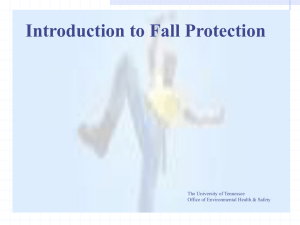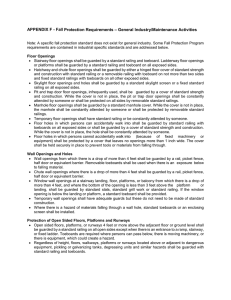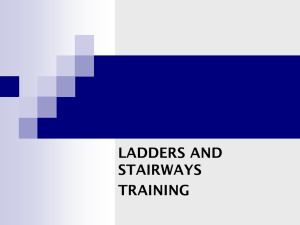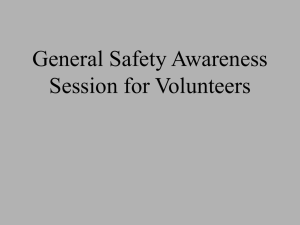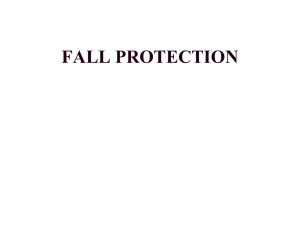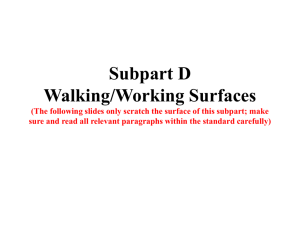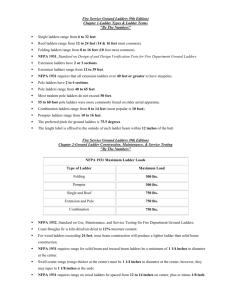OSHA Walking-Working Surfaces Safety Presentation
advertisement
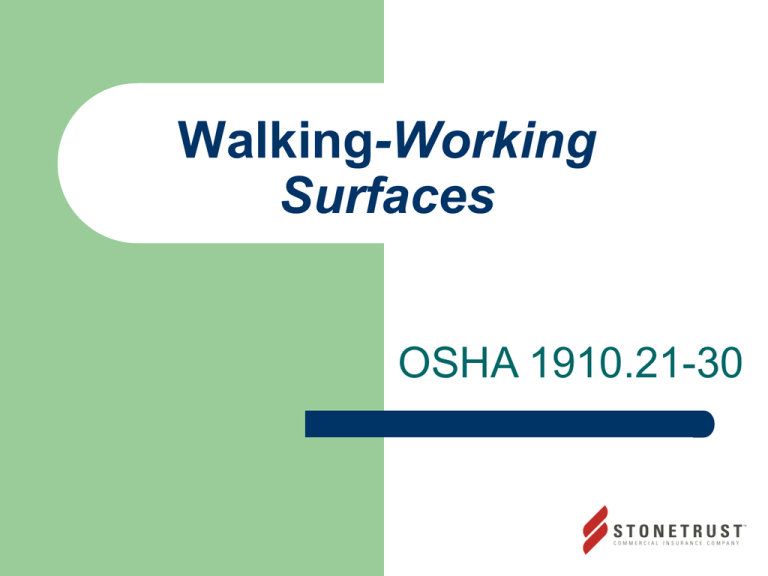
Walking-Working Surfaces OSHA 1910.21-30 Introduction Slips, trips and falls cause more on-job deaths than anything except vehicle accidents. OSHA’s 1910.21-30, for walking and working surfaces, applies to all permanent places of employment, except domestic, mining, or agricultural work. Housekeeping Workplaces must be kept clean, orderly, and sanitary. Workroom floors must be maintained as clean and dry as possible. Aisles and Passageways Keep clear. Move obstructions that create a hazard. Mark permanent aisles and passageways. Aisles must be wide enough for mechanical handling equipment. Covers and Guardrails Provide covers and/or guardrails to protect workers from the hazards of open pits, tanks, vats, ditches, and the like. Floor Loading Protection Load ratings must be posted conspicuously. Do not exceed the load rating limit. Max. 200 lbs. Floor Opening An opening measuring 12 inches or more in its least dimension in a floor, platform, pavement, or yard, through which persons may fall. Definitions Standard railing. Consists of top rail, mid rail, and posts. Height from the upper surface of top rail to floor level is 42 inches. Mid rail height is 21 inches. Standard toeboard. 4 inches high, with not more than ¼-inch clearance above the floor. Stairway Floor Openings Must be guarded by a standard railing on all exposed sides (except at entrance). Ladderway Floor Openings Guard with a standard railing with toeboard on all exposed sides (except entrance) Guard the passage through the railing with a swinging gate or offset it to prevent someone from walking into the opening Floor Hole An opening measuring 1 to 12 in. in a floor, platform, pavement or yard, through which materials but not persons may fall. Every floor hole must be guarded by either: – standard railing with toeboard – cover Wall Openings Opening at least 30 in. high and 18 in. wide, in a wall or partition, through which persons may fall. Wall openings from which there is a drop of more than 4 feet must be guarded. Open-Sided Floors and Platforms Open-sided floors or platforms 4 feet or more high must be guarded by standard railing on open sides, except where there is an entrance to a ramp, stairway, or fixed ladder. A toeboard is required when, beneath the open sides: – – – persons can pass, there is moving machinery, or there is equipment with which falling materials could create a hazard Open-Sided Floors, Walkways, Platforms, and Runways Regardless of height, a standard railing and toeboard must be used to guard: - open-sided floors - walkways - platforms, or - runways above or adjacent to dangerous equipment, tanks, and similar hazards. Stairways Flights of stairs with four or more risers must have standard stair railings or handrails. Fixed Industrial Stairs Treads must be slip resistant with uniform rise height and tread width. Must be able to carry 5 times expected load; minimum ofhere 1000 Violation – several steps bent and damaged pounds. Minimum width of 22 inches. Portable Ladders Extension ladders must extend at least 3 feet above the point of support. Withdraw defective ladders from service and tag or mark "Dangerous, Do Not Use“. Never use ladders in a horizontal position as scaffolds or work platforms. Never use metal ladders near electrical equipment. Never use step ladder as extension ladder. Extension Ladder Angle Use at angle where the distance from the foot of the ladder to the base of the structure is ¼ the height from base of structure to top support point of ladder. Fixed Ladders Permanently attached to a structure, building or equipment. Cages or wells required if longer than 20 ft. to a maximum unbroken length of 30 ft. Ladder safety devices may be used on tower, water tank and chimney ladders over 20 ft. in unbroken length instead of cage protection Scaffolding Capable of supporting four times the maximum intended load. Do not alter or move while in use. Protect workers on scaffolds from overhead hazards. If higher than 10 ft., use guardrails, midrails and toeboards. Use wire mesh between the toeboard and guardrail if people work or pass underneath. Must be equipped with access ladder. Summary Slips, trips, and falls constitute the majority of general industry accidents. OSHA’s standards for walking and working surfaces include requirements for housekeeping, guarding floor and wall openings and holes, industrial stairs and ladders. Keeping working surfaces clean, dry, and uncluttered can prevent many workplace accidents.
